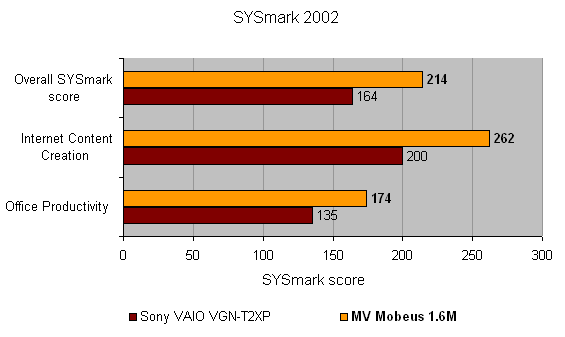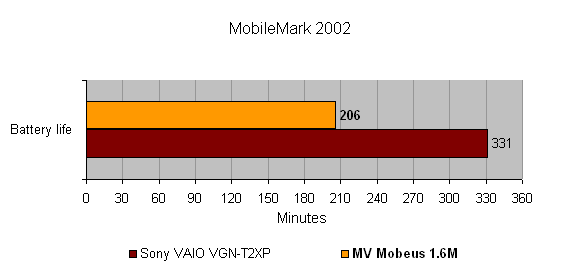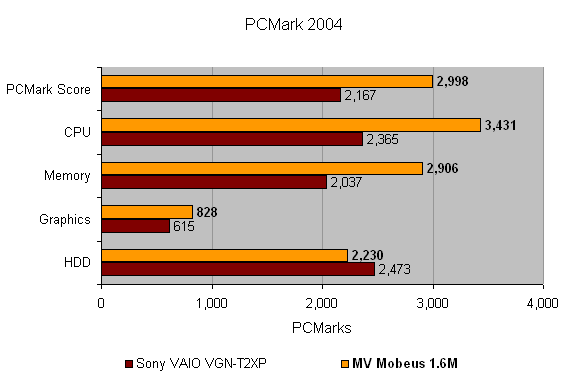MV Mobeus 1.6M Review
MV Mobeus 1.6M
As we revisit MV's Mobeus, it's clear that a fully featured lightweight notebook doesn't have to cost the earth.

Verdict
Key Specifications
- Review Price: £792.00
I first looked at the Mobeus from MV back in November 2004 – it was in fact the launch product from the company and it proved to be an impressive little machine at an attractive price. Things have moved on a little since then, so I figured it was worth revisiting the Mobeus and seeing what you’re getting for your money in today’s climate.
The market for thin and light notebooks seems to be growing all the time, and every time I look a new machine appears that redefines the genre. Only last week I looked at the Sony VAIO VGN-T2XP, which completely won me over, but there are a lot of mobile users out there who want something light and portable, but don’t have over £1,500 to spend. This is where the Mobeus comes in – it may not instil the same kudos when you take it out of your bag, but it is small, light, well featured and won’t break the bank.
Let’s get a few things straight first. the Mobeus doesn’t really fall into the ultra-portable category, with a weight of 2.1kg and dimensions of 290 x 230 x 38mm (WxDxH), but it’s certainly small and light enough to be carried around with you all day without you getting back ache. And to be fair, the super svelte Sony T2XP isn’t really what the Mobeus is competing against, it’s more akin to the Sony S range, like the VAIO S1VP I reviewed last year, which weighed in at 1.89kg.
Finished in matt silver and black, the Mobeus is reasonably pleasing to the eye, but it doesn’t have the WOW factor that, say, a Sony or Apple notebook might have. The lid is secured with a single, central catch and once lifted, a rather staid interior is revealed. Inside everything is black, with the exception of the power button, the “P” button (more on this later) and the two touchpad buttons. things aren’t helped by the fact that the default MV wallpaper is also black, but once you change it to something a little less sombre, the Mobeus brightens up a bit.
The screen is a 12.1in widescreen affair, with a native resolution of 1,280 x 800. This is a pretty decent amount of desktop real estate considering the size of the machine, and I found that I could work quite happily on the Mobeus running multiple applications without any trouble. In fact, most 4:3 aspect ratio thin and light notebooks sport a 1,024 x 768 native resolution, so you are getting considerably more desktop area with a widescreen solution like this. The screen also has a Crystal Bright coating, which is just like the X-Black finish offered by Sony or the X-Glass coating offered by Rock. This high contrast coating makes colours look superbly life like and vivid, which really shows through when watching movies, and with a widescreen display the Mobeus makes a nice little mobile movie player.
While I’m on the subject of watching movies, I’ll go back to that “P” button I mentioned earlier. Pressing this button while the machine is powered down will boot you into a small Linux partition running CyberLink PowerCinema. From here you can happily watch DVD movies without having to wait for Windows to load, and without the battery overhead that Windows carries with it. Definitely a good inclusion for a notebook designed to travel everywhere with you.
The keyboard is a decent enough example, although there is a note of flex as you type on it. That said, I was able to achieve a decent typing speed, but it wasn’t the almost pleasurable experience that I got when using the IBM ThinkPad X40. Also, the Return key is a little small, while the cursor keys could do with being separated from the main keyboard, rather than being flanked by the PgUp and PgDn keys.
When I first looked at the Mobeus I found that the touchpad was a little erratic to say the least, and unfortunately it hasn’t got better with time. Moving the pointer around the screen just isn’t as smooth or accurate as it should be. However, what I did find was that you just need to take your time with the touchpad – if you try to move the pointer very quickly, you might find it jumping randomly, but if you apply slightly slower movement, it works pretty well. Of course this still isn’t perfect, and realistically, you should be able to move your pointer as fast as you like.
Specification wise, the Mobeus has a 1.6GHz Intel Pentium M CPU driving it along, which makes up half of the Centrino package. The other half is an Intel PRO/Wireless 2915ABG WiFi adapter that supports 802.11a b and g standards. There’s 512MB of memory installed, but 14MB of this has been dedicated to the Intel integrated graphics.
The review unit that I have in front of me is equipped with a 40GB hard disk, but MV has told me that the Mobeus now ships with a 60GB drive at no extra cost. If you want to backup any data on your hard disk, you can use the integrated DVD writer, which will write to DVD+R/RW and DVD-R/RW, as well as DVD+R Dual Layer discs.
If you need to get connected, you’ll have no problem with the Mobeus. Besides that aforementioned WiFi adapter, there’s also a 10/100 Ethernet adapter and a 56k modem. But if you’re out and about and can’t track down a wireless hotspot, you can make use of the integrated Bluetooth to get connected via your mobile phone. The Bluetooth is also handy for getting photos off your phone, or transferring files to it, like really annoying ring tones.
Taking a tour around the chassis reveals a pretty well stacked right hand side – here you’ll find an Ethernet port, modem socket, S-Video out, a USB 2.0 port, a four-pin FireWire port, a Type II PC Card slot and headphone and mic sockets. The front is pretty bare except for a couple of indicator lights.
On the left is the DVD writer, a D-SUB connector and another USB 2.0 port. There’s also a memory card reader which will accept SD, MMC, MemoryStick and MemoryStick Pro variants. The rear is more or less barren, apart from the power socket and a Kensington lock point.
Performance wise the Mobeus turned in some reasonable numbers – with a 214 overall score in SYSmark 2002, general application usage will be no problem at all with this little beast, and from my own experiences using the Mobeus, I can testify to that. Mobile Mark turned in a battery life time of just under three and a half hours, which doesn’t come close to the five and a half hours from the Sony T2XP, but it is pretty respectable nonetheless.
I also have to give a mention to the integrated speakers in the Mobeus. These are by far the best speakers I’ve heard in a notebook this small, and they even have a bit of base behind them – ideal for when you’re using the Mobeus as a mobile DVD player.
So, the Mobeus is a small and light notebook, with a pretty strong feature set and solid performance, but the real selling point of this little machine is the price. With a price tag of only £791.82 including VAT, the Mobeus comes in at around half the cost of the Sony T2XP, making it something of a bargain.
”’Verdict”’
The MV Mobeus isn’t perfect, but its shortcomings can be forgiven when you consider the stunning price. OK, if money were no object, I’d take the Sony T2XP any day, but let’s be honest, money is an object to most people, a major one. So, if you’re looking for a small, reasonably light and well featured mobile companion, check out the Mobeus.




How we test laptops
Unlike other sites, we test every laptop we review thoroughly over an extended period of time. We use industry standard tests to compare features properly. We’ll always tell you what we find. We never, ever, accept money to review a product.
Trusted Score
Score in detail
-
Performance 8
-
Value 10
-
Features 8

